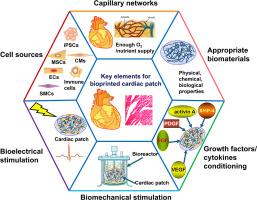A critical review on advances and challenges of bioprinted cardiac patches
IF 9.4
1区 医学
Q1 ENGINEERING, BIOMEDICAL
引用次数: 0
Abstract
Myocardial infarction (MI), which causes irreversible myocardium necrosis, affects 0.25 billion people globally and has become one of the most significant epidemics of our time. Over the past few years, bioprinting has moved beyond a concept of simply incorporating cells into biomaterials, to strategically defining the microenvironment (e.g., architecture, biomolecular signalling, mechanical stimuli, etc.) within which the cells are printed. Among the different bioprinting applications, myocardial repair is a field that has seen some of the most significant advances towards the management of the repaired tissue microenvironment. This review critically assesses the most recent biomedical innovations being carried out in cardiac patch bioprinting, with specific considerations given to the biomaterial design parameters, growth factors/cytokines, biomechanical and bioelectrical conditioning, as well as innovative biomaterial-based “4D” bioprinting (3D scaffold structure + temporal morphology changes) of myocardial tissues, immunomodulation and sustained delivery systems used in myocardium bioprinting. Key challenges include the ability to generate large quantities of cardiac cells, achieve high-density capillary networks, establish biomaterial designs that are comparable to native cardiac extracellular matrix, and manage the sophisticated systems needed for combining cardiac tissue microenvironmental cues while simultaneously establishing bioprinting technologies yielding both high-speed and precision. This must be achieved while considering quality assurance towards enabling reproducibility and clinical translation. Moreover, this manuscript thoroughly discussed the current clinical translational hurdles and regulatory issues associated with the post-bioprinting evaluation, storage, delivery and implantation of the bioprinted myocardial patches. Overall, this paper provides insights into how the clinical feasibility and important regulatory concerns may influence the design of the bioink (biomaterials, cell sources), fabrication and post-fabrication processes associated with bioprinting of the cardiac patches. This paper emphasizes that cardiac patch bioprinting requires extensive collaborations from imaging and 3D modelling technical experts, biomaterial scientists, additive manufacturing experts and healthcare professionals. Further, the work can also guide the field of cardiac patch bioprinting moving forward, by shedding light on the potential use of robotics and automation to increase productivity, reduce financial cost, and enable standardization and true commercialization of bioprinted cardiac patches.
Statement of significance
The manuscript provides a critical review of important themes currently pursued for heart patch bioprinting, including critical biomaterial design parameters, physiologically-relevant cardiac tissue stimulations, and newly emerging cardiac tissue bioprinting strategies. This review describes the limited number of studies, to date in the literature, that describe systemic approaches to combine multiple design parameters, including capabilities to yield high-density capillary networks, establish biomaterial composite designs similar to native cardiac extracellular matrix, and incorporate cardiac tissue microenvironmental cues, while simultaneously establishing bioprinting technologies that yield high-speed and precision. New tools such as artificial intelligence may provide the analytical power to consider multiple design parameters and identify an optimized work-flow(s) for enabling the clinical translation of bioprinted cardiac patches.

关于生物打印心脏贴片的进展与挑战的重要评论。
心肌梗塞(MI)会导致不可逆转的心肌坏死,影响全球 2.5 亿人,已成为当代最重要的流行病之一。在过去几年中,生物打印技术已经超越了简单地将细胞融入生物材料的概念,而是从战略角度定义了打印细胞所处的微环境(如结构、生物分子信号、机械刺激等)。在不同的生物打印应用中,心肌修复领域在管理组织修复微环境方面取得了一些最重要的进展。这篇综述对心脏补片生物打印领域的最新生物医学创新进行了批判性评估,具体考虑了生物材料设计参数、生长因子/细胞因子、生物力学和生物电调节,以及心肌组织的基于创新生物材料的 "4D "生物打印(三维支架结构+时间形态变化)、心肌生物打印中使用的免疫调节和持续给药系统。主要挑战包括生成大量心脏细胞的能力、实现高密度毛细血管网络的能力、建立与原生心脏细胞外基质相当的生物材料设计的能力,以及管理结合心脏组织微环境线索所需的复杂系统的能力,同时建立既高速又精确的生物打印技术。要做到这一点,必须同时考虑质量保证,以实现可重复性和临床转化。此外,本稿件还深入探讨了当前临床转化的障碍以及与生物打印后评估、存储、传输和植入生物打印心肌补片相关的监管问题。总之,本文深入探讨了临床可行性和重要的监管问题会如何影响与心脏补片生物打印相关的生物墨水(生物材料、细胞源)设计、制造和制造后流程。本文强调,心脏补片生物打印需要成像和三维建模技术人员、生物材料科学家、快速成型制造专家和医疗保健专业人员的广泛合作。此外,这项工作还能指导心脏补片生物打印领域向前发展,阐明机器人技术和自动化的潜在用途,以提高生产率、降低财务成本,并实现生物打印心脏补片的标准化和真正商业化。意义说明:这篇手稿对目前心脏补片生物打印的重要主题进行了重要综述,包括关键的生物材料设计参数、与生理相关的心脏组织刺激以及新出现的心脏组织生物打印策略。本综述介绍了迄今为止文献中数量有限的研究,这些研究描述了结合多种设计参数的系统方法,包括生成高密度毛细血管网络、建立类似于原生心脏细胞外基质的生物材料复合设计、结合心脏组织微环境线索的能力,同时建立了高速、精确的生物打印技术。人工智能等新工具可提供分析能力,以考虑多个设计参数并确定优化的工作流程,从而实现生物打印心脏补片的临床转化。
本文章由计算机程序翻译,如有差异,请以英文原文为准。
求助全文
约1分钟内获得全文
求助全文
来源期刊

Acta Biomaterialia
工程技术-材料科学:生物材料
CiteScore
16.80
自引率
3.10%
发文量
776
审稿时长
30 days
期刊介绍:
Acta Biomaterialia is a monthly peer-reviewed scientific journal published by Elsevier. The journal was established in January 2005. The editor-in-chief is W.R. Wagner (University of Pittsburgh). The journal covers research in biomaterials science, including the interrelationship of biomaterial structure and function from macroscale to nanoscale. Topical coverage includes biomedical and biocompatible materials.
 求助内容:
求助内容: 应助结果提醒方式:
应助结果提醒方式:


